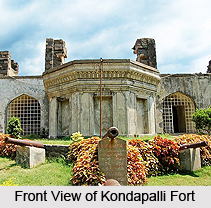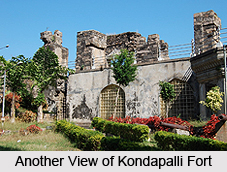 Kondapalli Fort is a famous monument in the Indian state of Andhra Pradesh. Also known as Kondapalli Kota, it is situated on the main hill range known as Kodapalli in the Krishna district. The ruins of the former citadel of the Kondapalli fort stand high over the walled enclosure of the old city, which is now overgrown. The architecture of this monument lures history lovers from various places of India.
Kondapalli Fort is a famous monument in the Indian state of Andhra Pradesh. Also known as Kondapalli Kota, it is situated on the main hill range known as Kodapalli in the Krishna district. The ruins of the former citadel of the Kondapalli fort stand high over the walled enclosure of the old city, which is now overgrown. The architecture of this monument lures history lovers from various places of India.
History of Kondapalli Fort
The fort was built in 1360 by the Hindu kings of the Reddy dynasty of Kondaveedu. In the past it was the site of a number of wars of conquest and power among different dynasties. The fort was seized by the Bahmani king Humayun the Cruel in 1458 and it was fiercely contested for over two and a half centuries. After having been under the control of the Bahmani Kingdom for a while, it went on to be occupied by the rulers of the Gajapati district of Odisha followed by Krishnadevaraya of Vijayanagar Empire, and from then on it fell into the hands of the Qutb Shahi dynasty. In 1687 it surrendered to the emperor Aurangzeb. On 10 March 1766 it was stormed and taken from the Nizam by the British under General Caillaud.
Architecture of Kondapalli Fort
The Kondapalli fort has been constructed as a majestic rock tower that rises up to three stories. The fort is entered through three massive gates, which lie in close succession at the foot of the hill. The first entrance is called the `Dargah Darwaza`. It is a 12 feet wide and 15 feet high gate that is built out of a single block of granite. Besides the Dargah darwaza, there is another entry gate called the Golconda darwaza located on the other end on the hill. This gate leads to the village of Jaggaiahpet. A stone staircase marks the ascent to the summit, which is fortified with towers and loopholed bastions.
 Above, lying at a crest between the two hills at the summit is the Tanisha Mahal or Palace. The palace is still well maintained. There is a cloistered ground storey and arched roofs found herein. It has many chambers on the ground floor and a huge hall on the upper floor. Above that is the great hall. The zenana quarters are approached along a terrace and enclosed by a high wall.
Above, lying at a crest between the two hills at the summit is the Tanisha Mahal or Palace. The palace is still well maintained. There is a cloistered ground storey and arched roofs found herein. It has many chambers on the ground floor and a huge hall on the upper floor. Above that is the great hall. The zenana quarters are approached along a terrace and enclosed by a high wall.
A path leads to the great reservoir, which is of immense depth and very cold. A spring surrounds the reservoir. Several bathrooms have stone pipes and cisterns. There are numerous other water tanks in the fort area which usually go dry during the winter months. Beyond the reservoir is the granary, a massive stone building with high arches and receptacles for grain. Behind this lie the magazines.
An old English barrack and burial ground are also found within the walls. The barrack has eight large rooms apart from a building at the annex. In addition, there are several buildings standing within the fort which are now in ruins. The Archaeological department of Andhra Pradesh has undertaken a number of projects for the renovation and restoration of the fort and the various structures located within it.
Significance of Kondapalli Fort
The Kondapalli Fort has served a number of different purposes at different points in time. Though originally built as a recreational House for the Kings, later it went on to develop into a thriving business centre. Its last known use was as a training base for the British rulers.



















